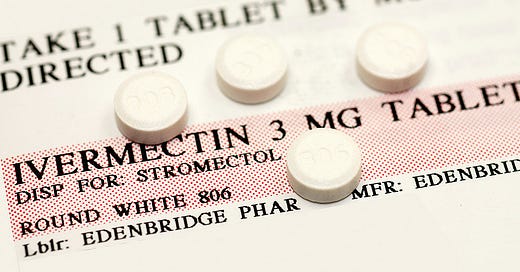
by Will Jones
Regular use of ivermectin led to a 100% reduction in hospitalisation rate, a 92% reduction in mortality rate and an 86% reduction in the risk of dying from a COVID-19 infection when compared to non-users, a major new study has found.
The study, published in the medical journal Cureus, analysed data from 223,128 people from the city of Itajaí in Brazil and is the largest study of its kind, giving its findings a high degree of certainty. Senior author Dr. Flavio A. Cadegiani wrote on Twitter: “An observational study with the size and level of analysis as ours is hardly achieved and infeasible to be conducted as a randomised clinical trial. Conclusions are hard to be refuted. Data is data, regardless of your beliefs.”


The study compared those who took ivermectin regularly, irregularly and not at all prior to being infected with COVID-19 (i.e., as prophylaxis), and found a dose-dependent relationship, confirming that the difference in outcomes is very likely to be due to the drug and not other factors, such as differences between the groups.
The authors used a technique called ‘propensity score matching’ to control for confounding factors that may otherwise have biased the study in one direction or another. For example, those taking ivermectin tended to be older than those not taking it (average age 47 years vs 40 years), but by matching people of similar age in each group and comparing outcomes this confounding factor was controlled for.
Here is the abstract of the study, which summarises the method and results.
Background
We have previously demonstrated that ivermectin used as prophylaxis for coronavirus disease 2019 (COVID-19), irrespective of the regularity, in a strictly controlled citywide program in Southern Brazil (Itajaí, Brazil), was associated with reductions in COVID-19 infection, hospitalisation, and mortality rates. In this study, our objective was to determine if the regular use of ivermectin impacted the level of protection from COVID-19 and related outcomes, reinforcing the efficacy of ivermectin through the demonstration of a dose-response effect.
Methods
This exploratory analysis of a prospective observational study involved a program that used ivermectin at a dose of 0.2 mg/kg/day for two consecutive days, every 15 days, for 150 days. Regularity definitions were as follows: regular users had 180 mg or more of ivermectin and irregular users had up to 60 mg, in total, throughout the program. Comparisons were made between non-users (subjects who did not use ivermectin), and regular and irregular users after multivariate adjustments. The full city database was used to calculate and compare COVID-19 infection and the risk of dying from COVID-19. The COVID-19 database was used and propensity score matching (PSM) was employed for hospitalisation and mortality rates.
Results
Among 223,128 subjects from the city of Itajaí, 159,560 were 18 years old or up and were not infected by COVID-19 until July 7th 2020, from which 45,716 (28.7%) did not use and 113,844 (71.3%) used ivermectin. Among ivermectin users, 33,971 (29.8%) used irregularly (up to 60 mg) and 8,325 (7.3%) used regularly (more than 180 mg). The remaining 71,548 participants were not included in the analysis. COVID-19 infection rate was 49% lower for regular users (3.40%) than non-users (6.64%) (risk rate (RR): 0.51; 95% CI: 0.45-0.58; p < 0.0001), and 25% lower than irregular users (4.54%) (RR: 0.75; 95% CI: 0.66-0.85; p < 0.0001). The infection rate was 32% lower for irregular users than non-users (RR: 0.68; 95% CI: 0.64-0.73; p < 0.0001).
Among COVID-19 [infected] participants, regular users were older and had a higher prevalence of type 2 diabetes and hypertension than irregular and non-users. After PSM, the matched analysis contained 283 subjects in each group of non-users and regular users, [283] between regular users and irregular users, and 1,542 subjects between non-users and irregular users. The hospitalisation rate was reduced by 100% in regular users compared to both irregular users and non-users (p < 0.0001), and by 29% among irregular users compared to non-users (RR: 0.781; 95% CI: 0.49-1.05; p = 0.099). Mortality rate was 92% lower in regular users than non-users (RR: 0.08; 95% CI: 0.02-0.35; p = 0.0008) and 84% lower than irregular users (RR: 0.16; 95% CI: 0.04-0.71; p = 0.016), while irregular users had a 37% lower mortality rate reduction than non-users (RR: 0.67; 95% CI: 0.40-0.99; p = 0.049). Risk of dying from COVID-19 [once infected] was 86% lower among regular users than non-users (RR: 0.14; 95% CI: 0.03-0.57; p = 0.006), and 72% lower than irregular users (RR: 0.28; 95% CI: 0.07-1.18; p = 0.083), while irregular users had a 51% reduction compared to non-users (RR: 0.49; 95% CI: 0.32-0.76; p = 0.001).
Conclusion
Non-use of ivermectin was associated with a 12.5-fold increase in mortality rate and a seven-fold increased risk of dying from COVID-19 compared to the regular use of ivermectin. This dose-response efficacy reinforces the prophylactic effects of ivermectin against COVID-19.
The authors draw particular attention to the dose-dependent relationship as confirming the efficacy of the treatment:
The response pattern of ivermectin use and level of protection from COVID-19-related outcomes was identified and consistent across dose-related levels. The reduction in COVID-19 infection rate occurred in a consistent and significant dose-dependent manner, with reductions of 49% and 32% in regular and irregular users, when compared to non-users. The most striking evidence of ivermectin’s effectiveness was the 100% reduction in mortality for female regular users.
The data come from official government databases and, according to the authors, “conclusively show that the risk of dying from COVID-19 was lower for all regular and irregular users of ivermectin, compared to non-users, considering the whole population”.
The study, while not a randomised controlled trial (RCT), used a “strictly controlled population with a great level of control for confounding factors” and was larger than would be feasible in an RCT.
The authors highlight a “notable reduction in risk of death in the over 50-year-old population and those with comorbidities”.
They conclude that the evidence provided by the study is “among the strongest and most conclusive data regarding ivermectin efficacy”.
Many governments have suppressed the use of ivermectin to treat COVID-19, claiming there is a lack of evidence of efficacy. However, this purported lack of evidence often relies on poorly designed trials and biased conclusions. For example, a recent widely-reported RCT on the use of ivermectin as a medical treatment concluded that it “did not show adequate support for the effectiveness of this drug” – yet its own results showed statistically significant benefits for speed of recovery as well as large (though not, in that trial, statistically significant) benefits for mechanical ventilation and death. Participants also were not given the treatment until over a week into having symptoms and the study may have been confounded by people in the placebo arm also taking the drug.
One of the new study’s authors and a seasoned proponent of repurposed treatments like ivermectin, Dr. Pierre Kory, made clear his thoughts on Twitter in April as he responded to an FDA tweet reminding the public that ivermectin is not approved: “Messaging BS with one corrupt study while ignoring 82 trials (33 RCTs) from 27 countries, 129K patients – sum showing massive benefits. Stop lying man, people are dying. #earlytreatmentworks.”



Social media companies have also censored information about ivermectin, considering any suggestion that it is a treatment for COVID-19 to be misinformation. Yet ivermectin is a cheap, safe drug that many studies have shown brings considerable benefit in treating and preventing COVID-19. The latest study impressively confirms this efficacy, with a reduction in mortality of up to 92%.
Shockingly, most governments still do not have a protocol for early treatment or prevention of COVID-19. The NHS says treatment is only available for those at high risk who have a positive test and symptoms that are not getting better. Its guidance on self-care for people ill at home only recommends paracetamol and ibuprofen. Yet here is a highly controlled study of over 200,000 people that shows huge benefit – 92% reduction in mortality, 100% reduction in hospitalisation – for the prophylactic use of a cheap, widely available drug, and which confirms the results of multiple earlier studies. What are our governments waiting for? What more do they need to approve drugs that have been shown to save lives?
Question: What are our governments waiting for?
Answer: The governments want you dead.
Question: Who are the governments actually working for?
Answer: Their One World Government owners.
Do NOT comply.















Ironically, it is the less-organized Third World countries that are basically over the pandemic. Western countries are over-civilized. They are governed by a corrupt elite obeyed by far too many people.
Big Pharma creates customers, not cures.